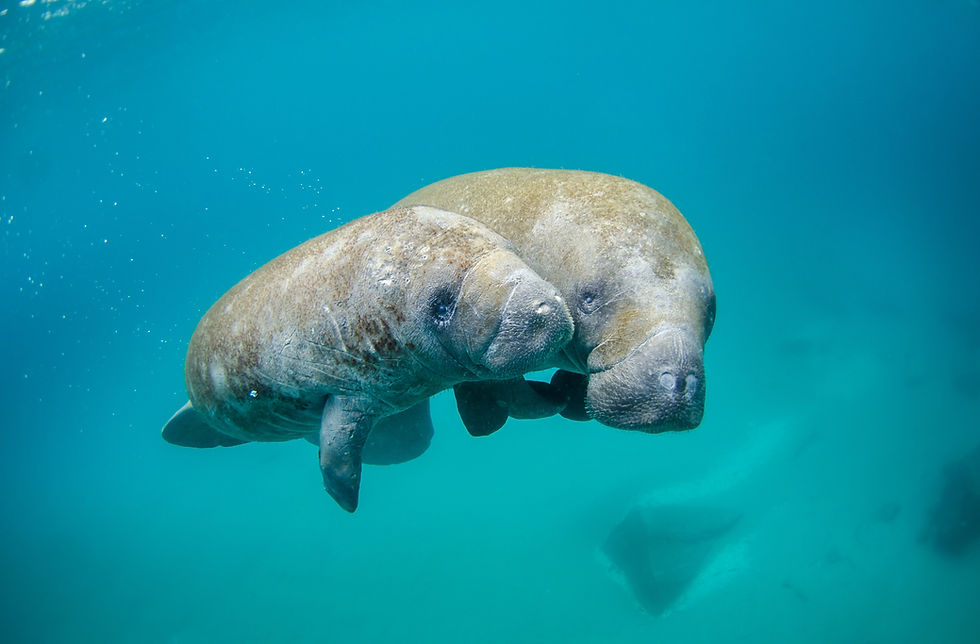Are Manatee Protection Laws Doing Enough?
- Seaside IT
- Mar 7, 2023
- 4 min read

Photo courtesy of Unsplash
In 2021, more than 1,000 manatees died in Florida, a record for the state despite manatee protection laws already in place. The manatee is a unique symbol of the southeast U.S., inspiring folklore and mermaid stories from early explorers. The West Indian Manatee, Trichechus manatus, is a large marine herbivore that inhabits the warm coastal waters of the southern U.S. East Coast, the Caribbean Sea, and further south in Brazil’s Atlantic coast. They are more closely related to elephants than any other marine mammal. U.S. waters are currently estimated to be home to a population of around 6,000 manatees, hosting one of only three manatee species found around the world. In the past, manatee populations were declining due to hunting; in the present their vulnerable populations are becoming increasingly threatened by habitat fragmentation and pollution.
The U.S. took action to protect this endemic species and other marine mammals by passing the Marine Mammal Protection Act of 1972 (MMPA). Main goals behind the legislation were to maintain ecosystem balance and function, and endorse the novel concept (at the time) of “optimum sustainable populations”. This aimed to avoid exploiting marine mammals through hunting and harvesting to the point where their role in the ecosystem was negated. It was acknowledged that manatees provide valuable ecosystem services, such as maintaining the overgrowth of aquatic vegetation and as a result, controlling mosquito populations. Following the MMPA a year later was the The Endangered Species Act of 1973 (ESA), which focused on preserving and recovering critically endangered species. The manatee was considered endangered under the ESA in 1973, and until 2017 they maintained that status.
Florida considers the manatee as their official state marine animal, and began protecting the “sea cows”, as they are sometimes fondly called, in the early 1800s through state laws. These preliminary laws eventually evolved into the Florida Manatee Sanctuary Act of 1978. Initially, these laws exclusively addressed manatee killing and hunting for sport. Now the legislation focuses on preventing collisions with boats, and creating natural safe havens in Florida rivers, bays, and estuaries where manatees can feed and reproduce peacefully without harassment from people. For example, no-entry zones have been established at the Crystal River and Blue Springs sites in Florida, creating a refuge that sees nearly 1,000 manatees on winter days when they are escaping cold Gulf waters. These collective laws helped increase manatee numbers from less than 1,000 in the late 1970’s to around 6,000 in the Southeast U.S. today, changing their status from “Endangered” to “Threatened”.
However, this decision to down-list their status may be premature. Recently the threats toward the manatee are not just limited to boating accidents and hunting. Manatee populations have been declining rapidly despite protective legislation surrounding them due to pollution and habitat loss. J.P. Brooker, the Director of Florida Conservation for Ocean Conservancy, stated that 24% of the manatee population in Florida has been lost over the past 2 years. Agricultural runoff has led to nutrient pollution, creating algae blooms in aquatic habitats that block out sunlight and prevent seagrass from growing, a staple food in the manatee diet. Another concern is the loss of habitat due to plastic pollution and debris. Manatees depend on the warm waters of Florida since they lack blubber to insulate themselves, but development near waterways in addition to the increased pollution has destroyed nesting areas. This suggests that maybe legislation is failing to keep up with current threats to manatee populations, and that it needs updating to address current threats, perhaps by revising the critical habitat designation and securing additional protected spaces.
In the meantime, action can be taken by communities and households to decrease the amount of runoff that can make its way into estuaries and oceans. This happens when excess water that the land can’t absorb picks up toxic chemicals and then flows into streams, rivers, and other bodies of water. Avoiding pesticides and fertilizers and reducing the amount of car-washing soaps and petroleum that can wash off of sidewalks into drainage systems are all ways to help combat toxic runoff and keep the oceans clean for manatees and marine animals.
References
Algae Blooms, seagrass loss, and manatee deaths. Save the Manatee Club. (2023, February 8). Retrieved February 28, 2023, from https://www.savethemanatee.org/how-to-help/take-action/floridas-algae-blooms/
Center for Biological Diversity. (2021, August 16). Changes sought for Florida Manatee Critical Habitat as deaths set new record. Center for Biological Diversity. Retrieved March 6, 2023, from https://biologicaldiversity.org/w/news/press-releases/changes-sought-for-florida-manatee-critical-habitat-as-deaths-set-new-record-2021-08-16/
Green , A. (2021, September 16). Four years ago manatees were declared no longer endangered. now they are dying at a record pace. WLRN. Retrieved February 28, 2023, from https://www.wlrn.org/news/2021-09-13/four-years-ago-manatees-were-declared-no-longer-endangered-now-they-are-dying-at-a-record-pace
Jones Jr., R. C. (2023, January 14). No longer endangered, manatees now face another crisis. University of Miami News and Events. Retrieved March 6, 2023, from https://news.miami.edu/stories/2022/02/no-longer-endangered,-manatees-now-face-another-crisis.html
O'Brien, M., & Toubman, W. (2022, February 10). Biologists take drastic measures to save Florida manatees at risk of starvation. PBS. Retrieved March 6, 2023, from https://www.pbs.org/newshour/show/biologists-take-drastic-measures-to-save-florida-manatees-at-risk-of-starvation#:~:text=In%20the%20late%201970s%20there,population%20had%20reached%20about%208%2C000.
Ocean conservationists concerned with sharp decline in manatee population. https://www.mysuncoast.com. (2022, November 1). Retrieved March 6, 2023, from https://www.mysuncoast.com/2022/11/01/ocean-conservationists-concerned-with-sharp-decline-manatee-population/
Over 300 Florida manatees dead in first six weeks of 2021. Oceanographic. (2021, February 24). Retrieved February 28, 2023, from https://oceanographicmagazine.com/news/florida-manatees-2021/#:~:text=The%20count%20of%20manatees%20in,survey%20of%20all%20wintering%20habitats.
Runoff. Education. (n.d.). Retrieved February 28, 2023, from https://education.nationalgeographic.org/resource/runoff/
Stormwater runoff pollution and how to reduce it. Stormwater runoff pollution and how to reduce it - King County. (n.d.). Retrieved February 28, 2023, from https://kingcounty.gov/services/environment/water-and-land/stormwater/introduction/stormwater-runoff.aspx
THE FLORIDA MANATEE SANCTUARY ACT. 68C-22 : The Florida Manatee Sanctuary Act - Florida Administrative Rules, law, code, Register - FAC, far, Erulemaking. (n.d.). Retrieved February 28, 2023, from https://www.flrules.org/gateway/ChapterHome.asp?Chapter=68C-22
US Department of Commerce, N. O. A. A. (2011, July 5). Endangered ocean: Manatees. Ocean Today. Retrieved March 6, 2023, from https://oceantoday.noaa.gov/endoceanmanatees/#:~:text=As%20new%20developments%20are%20built,manatees%20if%20they%20eat%20it.
Vargas, B. (2017, December 8). The good and the bad of the manatee sanctuary act. foundations of law and society. Retrieved February 28, 2023, from https://foundationsoflawandsociety.wordpress.com/2017/12/08/the-good-and-the-bad-of-the-manatee-sanctuary-act/


